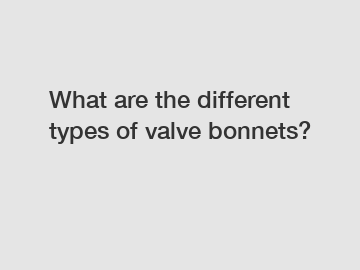Feb. 24, 2024
Construction & Real Estate
With competitive price and timely delivery, Afbv Valve sincerely hope to be your supplier and partner.
Valve bonnets are a critical component of industrial valves, serving as the cover for the valve body and providing protection for the internal parts of the valve. They come in various designs and styles, each suited for different applications and environments. In this blog, we will explore the different types of valve bonnets and their unique features.
1. Bolted Bonnet:

The bolted bonnet is one of the most common types of valve bonnets. It is secured to the valve body using bolts, providing a strong and durable seal. This type of bonnet is widely used in high-pressure and high-temperature applications where a secure closure is essential. Bolted bonnets can be easily removed for maintenance and inspection of the internal valve components.
2. Pressure Seal Bonnet:
Pressure seal bonnets are specifically designed for high-pressure applications. They use a metal-to-metal seal between the bonnet and the valve body, providing a tight and reliable closure under extreme pressure conditions. Pressure seal bonnets are commonly used in power plants, refineries, and other industrial settings where high pressures are a concern.
3. Welded Bonnet:
Welded bonnets are fabricated from the same material as the valve body and are welded directly to the valve body. This design creates a seamless and leak-proof seal, making welded bonnets ideal for high-pressure and high-temperature applications. Welded bonnets are known for their durability and resistance to corrosion, making them a popular choice in harsh environments.
4. Union Bonnet:
Union bonnets are a type of bonnet that can be easily removed and replaced without the need for special tools. They feature a threaded connection between the bonnet and the valve body, allowing for quick and straightforward maintenance. Union bonnets are commonly used in applications where frequent inspection and maintenance are necessary.
5. Bellows Bonnet:
Bellows bonnets are designed to provide a flexible and leak-proof seal for valves operating in high-temperature and high-pressure environments. The bellows act as a barrier between the process fluid and the bonnet, preventing leakage and ensuring the integrity of the valve. Bellows bonnets are commonly used in cryogenic applications, chemical processing, and other demanding settings.
6. Screwed Bonnet:
Screwed bonnets feature a threaded connection between the bonnet and the valve body, allowing for easy removal and reassembly. They are commonly used in low-pressure applications where frequent maintenance and inspection are not required. Screwed bonnets are easy to install and remove, making them a cost-effective option for many industrial applications.
7. Extended Bonnet:
Extended bonnets are designed to provide additional insulation and protection for valves operating in extreme temperature conditions. The extended length of the bonnet helps to keep the internal components of the valve cool and prevent damage from heat exposure. Extended bonnets are commonly used in cryogenic applications, fire-safe valves, and other high-temperature environments.
In conclusion, valve bonnets come in a variety of designs and styles, each suited for different applications and operating conditions. Whether you are working with high-pressure steam, corrosive chemicals, or extreme temperatures, there is a valve bonnet available to meet your specific needs. By understanding the different types of valve bonnets and their unique features, you can choose the right option for your industrial application and ensure the safe and efficient operation of your valves.
For more information, please visit Forged Steel Bellow Seal Globe Valve.
If you are interested in sending in a Guest Blogger Submission,welcome to write for us!
All Comments ( 0 )